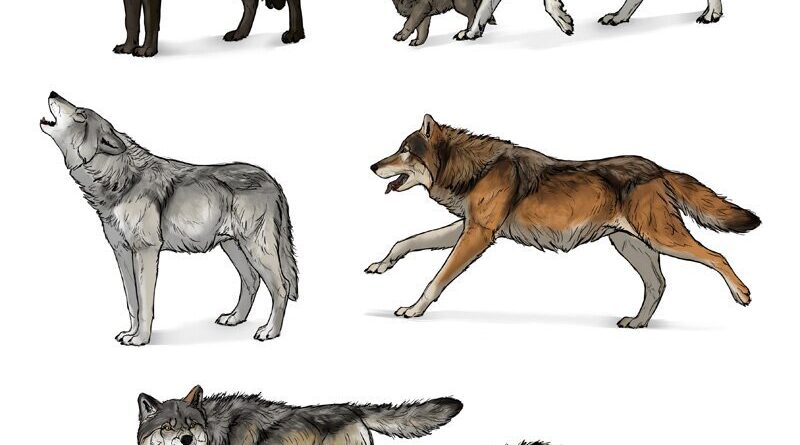Easy Steps To Learn How To Draw Wolf: Expert Tips & Tricks
To draw a wolf successfully, it’s essential to capture its majestic features and essence. Begin by sketching the outline of the wolf’s body with fluid, confident strokes. Focus on detailing the distinctive features like its pointed ears and sharp eyes to bring the wolf to life on paper. Gradually build up the shading and textures to add depth and realism to your drawing. Let’s dive into the process of how to draw a wolf and unleash your creativity on the canvas.
Learn How to Draw a Wolf: Step-by-Step Guide for Kids
Welcome, young artists! Are you ready to unleash your creativity and master the art of drawing wolves? Wolves are fascinating animals known for their beauty and grace. In this step-by-step guide, we will explore the exciting world of wolf drawing. Grab your pencils and paper, and let’s get started on this artistic adventure!
Materials You Will Need
Before we begin drawing our majestic wolf, let’s gather all the necessary materials:
Materials:
- Pencils (HB, 2B, and 4B)
- Eraser
- Drawing paper
- Ruler
- Reference images of wolves
Step 1: Basic Outline
Start by drawing a basic outline of the wolf using your HB pencil. Begin with a simple oval shape for the head and a curved line for the body. Add smaller circles for the ears and a long, curved line for the tail. Remember, it’s okay to make light, sketchy lines at this stage as we will refine the details later.
Step 2: Add Details to the Face
Now, let’s focus on the wolf’s face. Draw two almond-shaped eyes and a triangular-shaped nose in the center of the head. Add small dots for the whisker spots on each side of the nose. Wolves have pointed ears, so draw two triangular-shaped ears on top of the head.
Step 3: Fur and Body Details
Next, add details to the wolf’s body. Wolves have thick fur, so use your 4B pencil to sketch fur lines along the body. Pay attention to the direction of the fur, which usually follows the contours of the wolf’s body. Add details like the paws and claws to give your wolf a realistic look.
Step 4: Refine and Shade
Now that you have the basic outline and details, it’s time to refine your drawing. Use your 2B pencil to darken the lines and add shading to create depth. Shade the wolf’s fur by adding lighter and darker tones to give it a three-dimensional appearance. Don’t forget to blend the shading with your fingers or a blending stump for a smooth finish.
Step 5: Final Touches
Finally, add any finishing touches to your wolf drawing. You can emphasize certain features by adding more details or highlights. Use your eraser to clean up any smudges or unwanted lines. Take a step back and admire your masterpiece!
Tips for Drawing Wolves
Here are some tips to help you improve your wolf drawing skills:
Study Wolf Anatomy:
Take time to observe and study the anatomy of wolves. Understanding their body structure and features will help you create more realistic drawings.
Practice Regularly:
Like any skill, drawing takes practice. Set aside time each day to practice drawing wolves and other animals to hone your skills.
Use References:
Don’t be afraid to use reference images of wolves to guide your drawing. References can help you capture the essence of these magnificent creatures.
Congratulations, young artists! You have successfully learned how to draw a wolf through this step-by-step guide. Remember, practice makes perfect, so keep exploring your artistic talents and have fun creating beautiful wolf drawings. Let your imagination run wild as you continue to develop your drawing skills. Happy drawing!
Stay tuned for more exciting drawing tutorials and unleash your creativity one sketch at a time!
How To Draw A Realistic Wolf
Frequently Asked Questions
How can I start drawing a wolf?
To begin drawing a wolf, start by sketching the basic shapes such as circles and ovals to outline the body and head. Pay attention to the proportions and position of features like the snout, ears, and eyes. This initial sketch will serve as the foundation for detailing the wolf’s anatomy.
What are some key features to focus on when drawing a wolf?
When drawing a wolf, key features to focus on include the characteristic pointed ears, the shape and size of the eyes, the muzzle, and the fur texture. Pay attention to the wolf’s body structure and posture to capture the essence of these majestic creatures.
How can shading enhance the realism of a wolf drawing?
Shading plays a crucial role in adding depth and realism to a wolf drawing. Use different shading techniques such as hatching and blending to create light and shadow, emphasizing the wolf’s form and adding dimension. Pay attention to light sources to achieve a more realistic depiction.
What are some tips for capturing the wild and fierce nature of a wolf in a drawing?
To convey the wild and fierce nature of a wolf in your drawing, focus on capturing the intensity in the eyes and the subtle details of the fur texture. Experiment with different expressions and poses to evoke the essence of these powerful animals. Consider incorporating elements like a forest background to enhance the overall atmosphere.
Final Thoughts
In conclusion, mastering how to draw a wolf requires practice and attention to detail. Start by studying wolf anatomy and observing their natural movements. Utilize basic shapes to outline the body and focus on capturing the distinctive features of the wolf, such as the pointed ears and bushy tail. With patience and persistence, anyone can improve their ability to draw a wolf realistically. Keep practicing and exploring different techniques to develop your skills in drawing wolves effectively.

